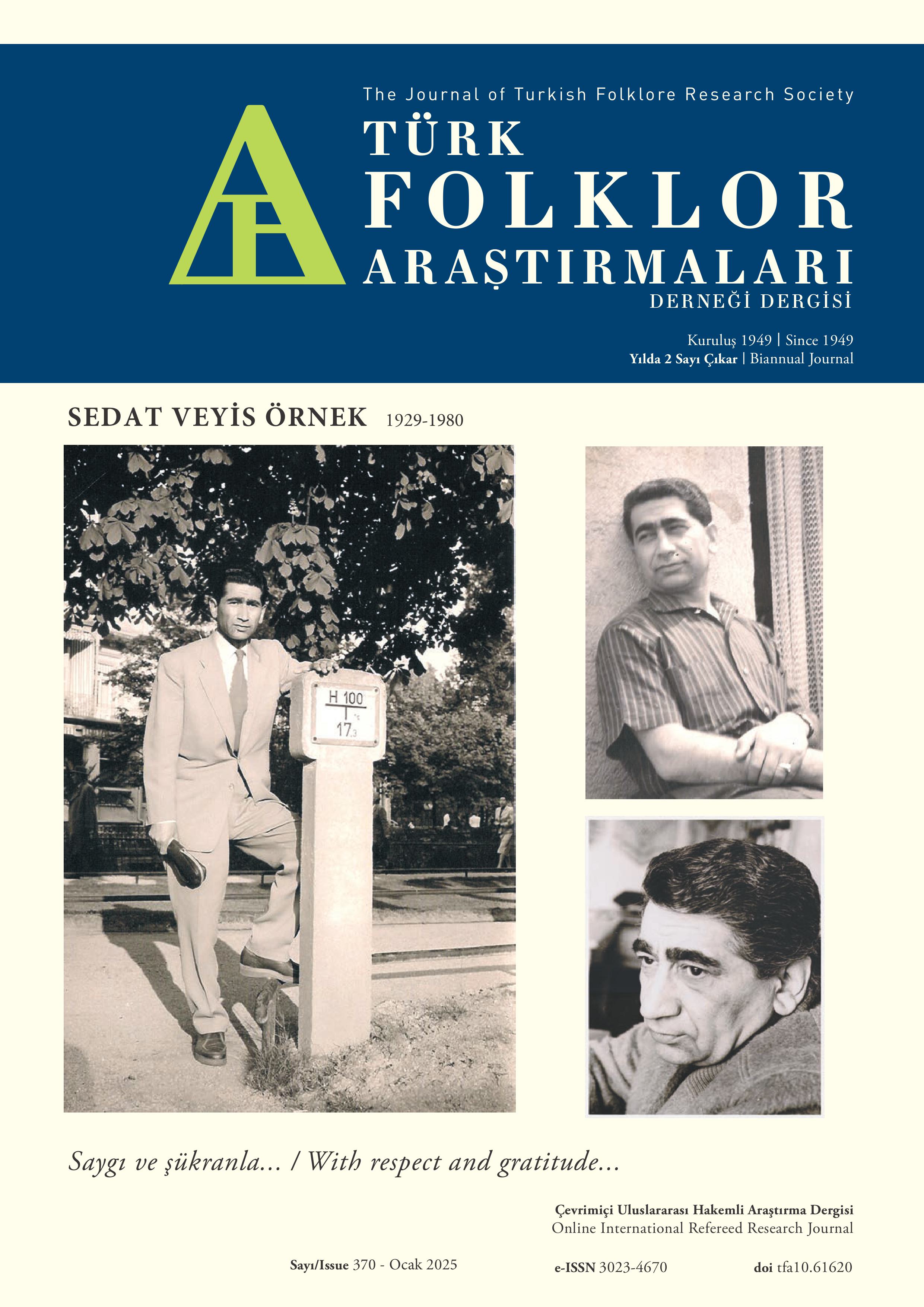Andrea Arnold’un İnek Filmi ve Otoetnografik Çağrışımları
DOI:
https://doi.org/10.61620/tfa.57Anahtar Kelimeler:
inek, otoetnografi, çok türlü etnografi, hayvan hakları, kadın çalışmalarıÖzet
Bu çalışmada İngiliz yönetmen Andrea Arnold‘a ait olan İnek (Cow, 2021) filmini yönetmenin bakış açısından anlamaya ve ekolojist bakış açısıyla değerlendirmeye çalıştım. Arnold’ın kendi hayatından izler taşıyan filmlerinde kadının, insan olmayan dişinin ve görünmeyenin çabasını görünür kılmaya dönük bir çaba vardır. Bu nedenle onun filmlerinde hayvanlar da birer karaktere dönüşür. İnek filminin ana karakteri Luma da bunun için özel olarak seçilmiştir. İnek filminin hayvan hakları ve kadın çalışmaları açısından güçlü iletileri bulunmaktadır. Film ayrıca etnografi için de yenilikçi ve örnek olabilecek özelliklere sahiptir. Bir belgesel niteliği taşıyan filmde kamera ineğin gözüne dönüşüyor ve bu bir yandan ineğin kendini aktarmasına olanak tanırken diğer yandan da izleyiciyi ineğin gözünden dünyayı anlamaya davet ediyor. Günümüzde yeni etnografinin yapmaya çalıştığı gibi, film onun hakkında konuşmak yerine, onunla yan yana durarak, ortaklaşa bir üretim sürecinin mümkün olduğunu gösteriyor. Yazımda esas olarak filmi anlamaya çalıştım fakat bunun yaptığı çağrışımlar kendi dünyamın inek ve insan ilişkileri üzerine de düşünmeme neden oldu. Böylece yazı iki ana eksende gelişti: Birincisinde yönetmenin kim olduğuna, İnek filmine ve filmdeki ana karakter Luma’nın neyi anlattığına odaklanırken ikincisinde tüm bunların benimle ilgisinin ne olduğuna ilişkin yanıtlar aradım. Birinci kısımda filmi çoklutürler etnografisi ya da posthümanist (oto)etnografinin açılımıyla anlamaya çalıştım. İkinci kısımda filmin benimle ilgisini, filmin çağrıştırdıkları üzerinden otoetnografik bir yaklaşımla ele alırken aynı zamanda insanın inekle ilişkilerine dair düşüncelerimi derinleştirmeye çalıştım. Sonuçta film, bütün gerçekliğiyle Luma’nın çabasını görmemizi ve takdir etmemizi sağlıyor. Film aynı zamanda bana kendi çevremdeki insan-hayvan ilişkilerini düşündürttüğü gibi herkesin daha iyi bir dünya için bu ilişkileri yeniden gözden geçirmesine de imkân veriyor.
Referanslar
Abrell, E. & Gruen, L. (2020). Ethics and animal ethnography working paper.
Wesleyan Animal
Studies.https://www.wesleyan.edu/animalstudies/WASEvents/FinalEthicsandAnima
lEthnographyDraft.
Adams T. E, Holman Jones S., Ellis, C. (2015). Autoethnography. New York: Oxford University.
Akın, S. (1996). Makiler. İstanbul: Cem.
Altuntek, N. S. (2009) ‘Yerli’nin bakışı, etnografya: Kuram ve yöntem. Ankara: Ütopya.
Aygün Cengiz, S. (Hzl.) vd. (2021) Onun kitabını anlatıyorum, Renato Rosaldo The day of Shelly’s death: The poetry and ethnography of grief (Shelly’nin öldüğü gün: Yasın şiiri ve etnografisi), Ankara: Ürün.
Balkır, N. (2019). Rembrandt’tan Damien Hirst’e sanatta hayvan karkasının temsili. İdil Sanat ve Dil Dergisi 8 (63), 1415-1420.
Burgan, E. (2017). Çoklu türler etnografisi: Yüz yüze bir araştırma imkanı üzerine düşünceler. Moment Dergi, 4(1): 115-134.
Butler, J. (2005). Kırılgan hayat. Yasın ve şiddetin gücü. (B. Ertür, Çev.) İstanbul: Metis.
Burul, Y. (2022) Şefkat ve zulüm hakkında her şey. Altyazı Sinema Dergisi. https://altyazi.net/soylesiler/andrea-arnold-ile-inek-uzerine-soylesi/
Ellis, C. (2004). The Ethnographic I: A methodological novel about autoethnograpy. AltaMira.
Ellis, C., Adams, T. E. & Bochner, A. P. (2010). Autoethnography: An overview [40 paragraphs]. Forum Qualitative Sozialforschung / Forum: Qualitative Social Research, 12(1), Art. 10, http://nbn-resolving.de/urn:nbn:de:0114-fqs1101108.
Freeman C. P., Tulloch, S. (2013). Was blind but now I see: Animal liberation documentaries’ deconstruction of barriers to witnessing injustice. In A. Pick & G. Narraway (Eds) Screening Nature: Cinema beyond the human Ch. 6. Oxford: Berghahn Books.
Gremels, A. (t.y.). Opacity (Édouard Glissant). Keywords in transcultural English studies.
http://www.transcultural-english-studies.de/opacite-opacity-edouard-glissant/.
Gülbay, F. (2021). Flanözün sanatı: Fotoğraflarla otoetnografik bir yürüyüş. Hacettepe Üniversitesi, Sosyal Bilimler Enstitüsü, İletişim Bilimleri Anabilim Dalı, Yüksek Lisans Tezi.
Hattenstone, S. (2022). I kept saying – don’t worry Luma, we see you: Andrea Arnold on her four years filming a cow. The Guardian, 6 Ocak 2022. https://www.theguardian.com/film/2022/jan/06/i-kept-saying-dont-worry-luma-we-see-you-andrea-arnold-on-her-four-years-filming-a-cow.
Ingram, D. (2013) The aesthetics and ethics of eco-film criticism. Ecocinema theory and practice. (Stephen Rust, Salma Monani, and Sean Cubitt, Eds.)
Jardins, J. R. Des (2006). Çevre etiği, çevre felsefesine giriş. (R. Keleş, Çev.) Ankara: İmge.
Karabaşa, S. (2019) Geçmişteki gelecek: Sürdürülebilirlik arayışında köylülüğün yeniden keşfi. Ankara, Ürün E-Kültür Dizisi: 6.
McHugh, S. (2005). Toplumun aynasında köpek. (S. Çağlayan, Çev.) İstanbul: Kitapyayınevi.
Mills, B. (2015). Towards a theory of documentary representation for animals Get access Arrow, Screen, 56 (1), Spring 2015, 102–107.
Noyes, D. (2016) Humble theory: Folklore’s grasp on social life. Indiana: Indiana University.
Özçürümez Bilgili, G. (2021). İlongotların izinde yas ve melankoli. Onun kitabını anlatıyorum. Renato Rozaldo. (Hzl. S. Aygün Cengiz), e-kültür dizisi: 14, 428-467. Ankara: Ürün Yayınları
Poulos, C. N. (2009) Accidental Ethnography, An inquiry into family Secrecy. California: Left Coast.
Regan, T. (2007). Kafesler boşalsın, hayvan haklarıyla yüzleşmek. (S. Çağlayan, Çev.) İstanbul: İletişim.
Robinson, L. C. (2011) Posthumanist (auto)ethnography: Toward the ethical representation of other animals. Master Thesis, Colorado State Universty.
Siddiq, A. B. ve Habib, A. (2017). Antropoloji’de ortaya çıkan çok-disiplinli güçlü bir alt bilim: Antrozooloji. Artuklu Human and Social Science Journal. 2 (1): 22-35.
Smaill, B. (2016). Regarding Life: Animals and the documentary moving image. Suny.
Szarkowski, J. (1978). Mirrors and windows: American photography since 1960. The Museum of Modern Art: Distributed by New York Graphic Society.
Taylor, C. (2008). The precarious lives of animals: Butler, Coetzee, and animal ethics. Philosophy Today.45 (1): 60-72.
İndir
Yayınlanmış
Nasıl Atıf Yapılır
Sayı
Bölüm
Lisans
Telif Hakkı (c) 2025 Solmaz Karabaşa

Bu çalışma Creative Commons Attribution 4.0 International License ile lisanslanmıştır.



